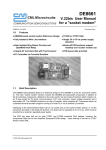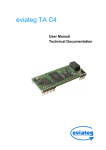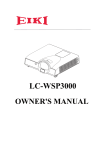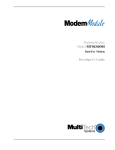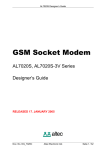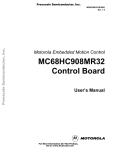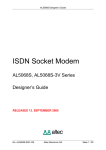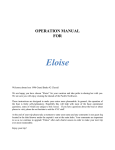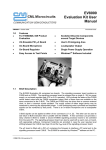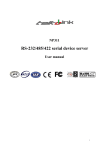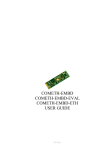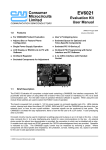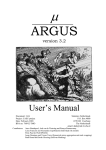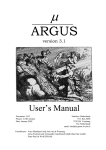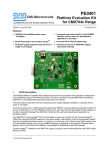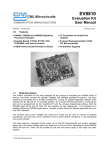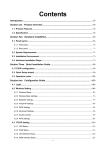Download DE8691 - Electronics Datasheets
Transcript
DE8691 Demonstration Board User Manual UM8691/4 August 2006 Provisional Issue Features • CMX869B-based Socket Modem Demonstration • PC Controlled via Terminal Emulator • Fully Isolated 2-Wire Line Interface • DAA included • Opto Isolated Ring Detect Circuitry and OptoMOS Hook Relay • Single 3.3V dc power supply operation • ‘AT’ Command Compatible Firmware • Break-off PCB section • On-board FLASH PIC Microcontroller • PCB layout data available 1. Brief Description The DE8691 Demonstration Board features the CMX869B V.32 bis modem IC in a "socket modem format" implementation. The "socket modem" section also contains the line interface components and a Flash PIC µC. Attached to the "socket modem" section are two break-off sections, which contain a 9-pin D type socket for PC serial communications, a Flash PIC programming connector, an RJ11 line connector and various LEDs for indicating signal activity. AT Commands are used to control the demonstration board via a standard terminal emulator program running on a host PC. Interfacing to the Demonstration Board can be via socket pins on the socket modem section, or via the connectors provided on the break-off sections. The board is operated at 3.3V dc, which must be provided by an external, regulated power supply. © 2006 CML Microsystems Plc CMX869B Demonstration Board DE8691 CONTENTS Section Page 1. Brief Description ..................................................................................... 1 2. Preliminary Information.......................................................................... 4 2.1 Laboratory Equipment............................................................... 4 2.2 Handling Precautions ................................................................ 4 2.3 Approvals.................................................................................... 4 3. Quick Start ............................................................................................... 5 3.1 Setting-Up ................................................................................... 5 3.3 Operation .................................................................................... 5 4. Signal Lists .............................................................................................. 7 5. Circuit Schematics and Board Layouts.............................................. 10 6. Detailed Description ............................................................................. 11 6.1 Hardware Description.............................................................. 11 6.2 Firmware Description .............................................................. 11 6.3 Software Description............................................................... 24 6.4 Additional Information............................................................. 26 6.5 Troubleshooting....................................................................... 27 7. Performance Specification................................................................... 28 7.1 Electrical Performance ............................................................ 28 It is always recommended that you check for the latest product datasheet version from the Datasheets page of the CML website: [www.cmlmicro.com]. © 2006 CML Microsystems Plc 2 UM8691/4 CMX869B Demonstration Board DE8691 Modem or Telephone Line Simulator J3 DE8691 J6 Power Supply J4 RS232 Cable IBM-PC Figure 1 - Block diagram © 2006 CML Microsystems Plc 3 UM8691/4 CMX869B Demonstration Board 2. Preliminary Information 2.1 Laboratory Equipment DE8691 The following laboratory equipment is needed to use this demonstration board: 2.1.1 3.3Vdc Regulated Power Supply 2.1.2 A PC equipped with a serial port running a terminal emulation program such as Microsoft HyperTerminal. 2.1.3 For PIC re-programming with the software supplied (ESFlash_xx.exe), an IBM compatible PC, or better, running Microsoft WindowsTM 98,NT,2000,XP. 2.2 Handling Precautions Like most demonstration boards, this product is designed for use in office and laboratory environments. The following practices will help ensure its proper operation. 2.2.1 Static Protection This product uses low power CMOS circuits which can be damaged by electrostatic discharge. Partially damaged circuits can function erroneously, leading to misleading results. Observe ESD precautions at all times when handling this product. 2.2.2 Contents - Unpacking Please ensure that you have received all of the items on the separate information sheet (EK8691) and notify CML within 7 working days if the delivery is incomplete. 2.3 Approvals This product is designed to meet CTR21/FCC68 telecom approval requirements and comes pre-configured with the FCC68 DAA. Users are advised to observe local statutory requirements, which may apply to this product before direct or indirect connection to any public telecommunication system. © 2006 CML Microsystems Plc 4 UM8691/4 CMX869B Demonstration Board 3. DE8691 Quick Start This section provides instructions for users who wish to experiment immediately with the demonstration board. A fuller description of the board and its use appears later in this document. 3.1 Setting-Up THE DE8691 IS FITTED WITH A CMX869B TSSOP DEVICE AND A PRE-PROGRAMMED FLASH PIC µC, FOR OPERATION AT 3.3 VOLTS. THE TERMINATING LINE IMPEDANCE OF THE DAA IS PRE-CONFIGURED FOR 600 OHMS. To change the terminating line impedance of the DAA see section 6 for alternative component values. An RJ11 (US style) phone jack, J3, for 2-wire line connection is provided on one of the break-off board sections. Power is connected via J6 1(VDD) and 2(GND). Attach a 9-way RS232 cable (not supplied) between connector J4 and the serial port of the PC. Connect an external modem/line simulator to the demonstration board using a suitable RJ11 telephone cable (not supplied). The DE8691 is supplied with the break-off sections of the board intact. If a socket modem using the industry standard footprint is required, detach these break-off sections from the Demonstration Board PCB by using a suitable tool to scribe along the perforations that join the break-off sections to the main PCB. Scribe on both top and bottom sides of the board and ensure that the scribed line completely cuts any copper tracks entering or leaving the break-off sections from the main PCB. When this is done, gently break-off the first section on which connector J4 (9-pin D Type socket) is mounted, then break-off the second section on which the RJ11 socket is mounted. All connections to the remaining socket modem must now be made through the PCB connector pins. 3.2 Operation The DE8691 demonstration board allows the user to perform calling, answering and simple data transfer with a suitable simulator or external third party modem (not supplied). The board is controlled by the AT command set described in Section 6.2, by running a terminal emulator program on the host PC. A suitable emulator is the ‘HyperTerminal’ program, which operates under Windows systems. The DE8691 AT command set consists of Basic, Extended and CML Specific commands. The board has three modes of operation: AT Command Mode In this mode the command processor firmware is constantly checking to see if the user has typed a valid AT command. When a valid command is received the firmware will execute that command. While the firmware is operating in this mode, the user can instruct it to manually answer a call, originate a call, go on/off hook, read/write to S-registers, issue CML specific AT commands, or perform other AT command functions. The board always starts in AT Command mode after power is applied and board initialisation is complete. © 2006 CML Microsystems Plc 5 UM8691/4 CMX869B Demonstration Board DE8691 The CML specific AT commands allow the user to directly control the CMX869B device for evaluation purposes. Note, customer modified CMX869B device registers will be overwritten when Dial and Answer AT commands are executed. The Dial and Answer commands will execute the relevant DTMF transmit, call progress tone detection and negotiation (handshaking) firmware routines before a connection to a remote modem/simulator can be established. Negotiation may be aborted by pushing any key. Note, if the S0 register is modified to a non-zero value during this operating mode, the CMX869B status register will be polled every 20ms to check for ring detect status. If valid ringing is detected the DE8691 will automatically answer a call after n ring cycles, where n is equivalent to the contents of the S0 register. Data Transfer Mode After gaining a connection (i.e. successful negotiation) with a remote modem the board will be operating in data transfer mode. In this mode the board will transmit all the data it receives from the RS232 computer terminal to the remote modem via the 2-wire line. Likewise any data received from the remote modem via the 2-wire line will be sent to the RS232 computer terminal. Whilst operating in this mode the data stream from the RS232 computer terminal is monitored for the escape code sequence (+++). If this sequence is encountered during data transfer the firmware will revert to on-line AT command mode. Whilst in on-line, AT command mode, the board to remote modem connection may be aborted by typing ATH0 (instructs modem to go onhook). Alternatively the user can enter relevant AT commands or return to data transfer mode by using the ATO command. The modem line speed is much lower than the speed of the RS232 interface (RS232 is running at 19200bps) and the DE8691 firmware only provides a small amount of data buffering. Therefore to prevent the data buffer from overflowing the data flow between the µC and RS232 is controlled by the RTS/CTS (Request/Clear to Send) hardware handshake lines. The CMX869B settings used during negotiation and data transfer will be based on the contents of the S-registers when the call was originated or answered. The S-registers are described in Section 6.2.6. Certain S-register settings (relevant to the CMX869B configuration), modified during on-line AT command mode, will only take effect when a new call is originated or answered. For example, new CMX869B Tx gain settings (S25 register) modified in on-line AT command mode will be ignored until the next call. CLI Type I Detection The DE8691 firmware will automatically detect a type 1 CLI message between the first and second rings of an incoming connection. If a valid CLI type 1 message is detected during this period then the message “CLI 1” is displayed. In order to cause the modem to detect CLI, users should enter command ATS0=n, where n is two or greater, before the modem is dialled. The contents of the last received CLI message can be viewed using the AT command AT@FC. A simple CLI message when displayed might produce something similar to the following. AT@FC 035 07182330 3367445050 Fred Bloggs OK © 2006 CML Microsystems Plc 6 UM8691/4 CMX869B Demonstration Board 4. DE8691 Signal Lists CONNECTOR PINOUT Connector Ref. Connector Pin No. Signal Name Signal Type Description J1 TIP Bi Socket pin - Tip J2 RING Bi Socket pin – Ring 3 RING Bi RJ11 connector – Ring 4 TIP Bi RJ11 connector – Tip 1 DCD Output 9-pin D Type connector – PC DCD 2 TXD Output 9-pin D Type connector – PC TXD 3 RXD Input 9-pin D Type connector – PC RXD 4 DTR Input 9-pin D Type connector – PC DTR 5 VSS Power 9-pin D Type connector – PC GND 6 DSR Output 9-pin D Type connector - PC DSR 7 RTS Input 9-pin D Type connector – PC RTS 8 CTS Output 9-pin D Type connector - PC CTS 9 RI Output 9-pin D Type connector – PC RI 1 /RESET Input 1 x 5 header – PIC reset 2 /CTSTTL Input 1 x 5 header – PIC programming data 3 /RTSTTL Input 1 x 5 header – PIC programming clock 4 VPP Power 1 x 5 header – PIC programming voltage 5 VSS Power 1 x 5 header Vss connection 1 VDD Power 1 x 3 header – Main Power Connection 2 VSS Power 1 x 3 header – Main Power Connection J24 /RESET Input Socket pin – PIC reset J26 VSS Power VSS connection J29 DCDIND Output Socket pin – DCD LED indication J30 RIIND Output Socket pin – RI LED indication J31 DTRIND Output Socket pin – DTR LED indication J32 DSRIND Output Socket pin – DSR LED indication J33 /RTSTTL Input Socket pin – PIC RTS J34 /RXDTTL Output Socket pin – PIC TXD J35 /TXDTTL Input Socket pin – PIC RXD J36 /RITTL Output Socket pin – PIC RI J37 /DSRTTL Output Socket pin – PIC DSR J3 J4 J5 J6 © 2006 CML Microsystems Plc 7 UM8691/4 CMX869B Demonstration Board DE8691 CONNECTOR PINOUT Connector Ref. Connector Pin No. Signal Name Signal Type Description J38 /CTSTTL Output Socket pin – PIC CTS J39 /DCDTTL Output Socket pin – PIC DCD J40 /DTRTTL Input Socket pin – PIC DTR J41 VSS Power Vss connection J61 VDD Power +ve power from external power supply J62 ~ N/C No connection should be made to this pin J63 AVSS Power Analogue Vss connection – Not used LEDs LED Ref. Description D6 Illuminated when a carrier is detected at the remote modem end of the line D7 Illuminated when the Socket Modem is detecting ringing on the telephone line. D8 Iluminated when the Socket Modem (DCE) asserts the Data Set Ready signal. D9 Illuminated when Data Terminal Ready is asserted by the host system. D10 Illuminated when the line is in an off-hook state JUMPERS Link Ref. JP1 Positions 1-2 Notes: Bi = N/C = © 2006 CML Microsystems Plc Default Position S/C Description Receiver enable (U8) Bidirectional No Connection 8 UM8691/4 CMX869B Demonstration Board DE8691 Figure 2 - Socket section pinout © 2006 CML Microsystems Plc 9 UM8691/4 CMX869B Demonstration Board 5. DE8691 Circuit Schematics and Board Layouts For clarity, circuit schematics are available as separate high resolution files. 89.0 + C18 D5 U3 R13 R16 C13 E1 + R9 C1 C26 C27 C28 JP1 C14 C17 R15 L1 R1 C19 C8 R10 R7 C7 C25 C10 C16 C15 C6 R6 X1 C11 R14 C9 R11 C12 R12 L2 C3 R8 R19 R17 T1 C4 U5 + C24 Board Mod 1 2 3 4 + R20 51.3 1 R25 R23 R24 R21 R22 GND VDD J3 J6 J4 R18 SW1 J5 D10 D6 D7 HOOK DCD RI D9 D8 DTR DSR F1 Figure 3 - Top view D2 + R5 R4 U2 C23 C22 RS4 RS3 C21 U4 C5 C20 D1 X2 D3 C2 RS2 L3 R2 RS5 R3 RS1 U1 TR1 1 D4 1 Figure 4 - Bottom view © 2006 CML Microsystems Plc 10 UM8691/4 CMX869B Demonstration Board 6. Detailed Description 6.1 Hardware Description 6.1.1 Line Interface DE8691 The DE8691 is shipped with a (FCC68) DAA, which presents an AC line termination of 600 ohms resistive. The user may alter the terminating impedance by fitting alternative values for components C3, C5, C6, R6 and R7. For CTR21 complex matching, the values are: C3 = 2.2µF, C5 = 56nF, C6 = 150nF, R6 = 220Ω, R7 = 680Ω 6.1.2 Clock/Oscillator The CMX869B is clocked at a frequency of 6.144MHz, which is provided by crystal X1. The PIC µC is clocked with a 20MHz crystal, X2. PIC microcontrollers programmed by CML are only configured for use with the on-board 20MHz crystal. 6.1.3 On-hook Caller ID This function provides a high impedance, on-hook AC path for the routing of Caller ID signals to the CMX869B. Components C2 and R14 provide this transmission path. C2 bypasses the optoMOS relay hook switch, allowing AC signals to pass through T1 when the Socket Modem is in an on-hook state. To compensate for losses incurred in the on-hook state, R14 and the Rx High gain option of the CMX869B increase the receive gain. 6.1.4 Line Protection Line protection is provided by the Sidactor component E1. Sidactor is the trade name for a type of Transient Voltage Suppressor (TVS) manufactured by Teccor Electronics. 6.1.5 Ring Detection The ring detect threshold is approximately 20VRMS. 6.2 Firmware Description The PIC18LF252-I/SP µC fitted on the DE8691 demonstration board has been programmed with the latest version of firmware by CML before shipment. Please read the separate information sheet (EK8691) and check the CML web site for firmware status. The latest source code and programming file (EF8691xx.HEX, where xx represents the version number) can be downloaded from the CML web site. The serial communications firmware supplied in the PIC µC assumes the following configuration: 8 data bits, no parity, 1 stop bit and 19,200 baud with hardware flow control. The firmware routine run at start-up and reset performs the following important tasks: Peripheral Interrupt Initialisation µC ports and I/O direction initialisation Serial Communication Interface (SCI) initialisation Serial Peripheral Interface (SPI) initialisation Loads factory profile 0 Resets CMX869B device © 2006 CML Microsystems Plc 11 UM8691/4 CMX869B Demonstration Board DE8691 The message EF8691 Vx.x, will be displayed in the terminal emulator window when these tasks have been completed. Note, the CMX869B device is always reset and powered up at the beginning of the negotiation. The firmware only supports DTMF dialling. AT command echoing is an option available in the firmware and involves echoing the received characters sent by the PC. The firmware also provides the option of sending result codes to the PC. These responses can be in either an alpha or numeric form. The AT command set for the DE8691 is tabulated below. These commands can be entered on a PC running Windows terminal emulator software, such as the ‘HyperTerminal’ program supplied with Windows installations. The ‘HyperTerminal’ Send Text File facility is useful for data transfer i.e. when the DE8691 has established a connection with a remote modem. This terminal emulator facility can also be used for sending AT command scripts to the DE8691. These scripts should consist of a single line, multiple AT command, for example. ATH1@RE0=4929@RE6?@RE1=4567<CR> The S-register contents are transferred into the C-BUS registers of the modem when a call is made or received (ATA, ATD or ATZn command is executed). © 2006 CML Microsystems Plc 12 UM8691/4 CMX869B Demonstration Board DE8691 6.2.1 Basic AT Commands Command Description A Answer Command The modem will go off-hook and attempt to establish a connection with a remote modem. Syntax: ATA<CR> A/ Re-Execute Previous Command Line Re-executes the last issued command line. This command does not require the AT prefix or a carriage return. Syntax: A/ Bn Select Communications Standard Selects the communications standard specified by the parameter n. Syntax: ATBn<CR> Modifier Usage n=0 Selects ITU-T V.32bis at 14k4bps QAM (default). n=1 Selects ITU-T V.32bis at 12kbps QAM. n=2 Selects ITU-T V.32bis at 9600bps QAM with trellis coding. n=3 Selects ITU-T V.32 at 9600bps QAM without trellis coding. n=4 Selects ITU-T V.32bis at 7200bps QAM. n=5 Selects ITU-T V.32 at 4800bps QAM. n=6 Selects ITU-T V.22bis at 2400bps QAM (default). n=7 Selects ITU-T V.22 at 1200bps DPSK. n=8 Selects ITU-T V.23 with Tx 75bps and Rx 1200bps FSK. n=9 Selects ITU-T V.23 with Tx 1200bps and Rx 75bps FSK. (NYI) n=10 Selects ITU-T V.21 at 300bps FSK. (NYI) n=11 Selects Bell 202 with Tx 150bps and Rx 1200bps FSK. (NYI) n=12 Selects Bell 202 with Tx 1200bps and Rx 150bps FSK. (NYI) n=13 Selects Bell 103 at 300bps FSK. n=14 Selects V.22bis manual mode at 2400bps. n=15 Selects V.22 manual mode at 1200bps. Protocol code n saved into S register 27 Dn Dial Command This command directs the modem to go off-hook, dial according to the string entered and attempt to establish a connection with a remote modem. The n represents an ASCII string composed of dial digits and dial modifiers and must not exceed the 15 character buffer limit. The DTMF tone dialling digits include 0 through 9, A, B, C, D, and the symbols # and *. Syntax: ATDn <CR> For example: ATD9,01621875500<CR> Modifier Usage n=L Re-dial last number. n=, Delay dial sequence (pause setting contained in S-Register S8). n= 0,1,2,3,4,5,6,7,8,9,A,B,C,#,* Dial the DTMF tone associated with each character. © 2006 CML Microsystems Plc 13 UM8691/4 CMX869B Demonstration Board Command En DE8691 Description Echo Command Characters Syntax: ATEn<CR> Modifier Usage n=0 Disables the echoing of commands to the screen. n=1 Enables echoing of commands to the screen (default). Setting saved into S register 14 bit 0. Hn Switch Hook Control Syntax: ATHn<CR> Modifier Usage n=0 Instructs the modem to go on-hook (disconnect). n=1 Instructs the modem to go off-hook. In Identification Requests the modem to return its product identification information. Syntax: ATIn<CR> Modifier Usage n=0 Displays the software version number. n=1 Displays Target Selection Designation (e.g. DE8691). Nn Modulation Fallback Option Applies to V.22bis manual mode operation only. Syntax: ATNn<CR> Modifier Usage n=0 When originating or answering, modem negotiates only at 2400bps (default). n=1 When originating or answering, modem falls back to 1200bps where conditions prevent a 2400bps line rate being established. Setting saved into S register 24 bit 3. O Return to Data Transfer Mode Used during on-line AT command mode, this command allows the user to return to data transfer mode. Note, this command does not initiate any retrain sequence. Syntax: ATO<CR> Qn Enable/Disable Modem Responses Syntax: ATQn<CR> Modifier Usage n=0 Enables result codes to be issued to the screen (default). n=1 Disables result codes to be issued to the screen. Setting saved into S register 14 bit 1. © 2006 CML Microsystems Plc 14 UM8691/4 CMX869B Demonstration Board Command Sn? DE8691 Description S-Register Read Command for displaying the contents of an S-Register (See S-Register Table). Syntax: ATSn?<CR> Sn=x where n is the S-Register to be interrogated (decimal). Value returned is either in decimal (default) or hex format depending on the setting of the AT&Hn command (S register 14 bit 3). S-Register Write Command for writing to an S-Register (See S-Register Table). Syntax: ATSn=x<CR> where n is the S-Register (decimal) and x is the value to be written in decimal or hex format depending in the setting of the AT&Hn command (S register 14 bit 3). Vn Result Code Format Syntax: ATVn<CR> Modifier Usage n=0 Instructs the modem to display result codes as numbers. n=1 Instructs the modem to display result codes as words (default). Setting stored into S register 14 bit 2. Xn Calling Characteristics Determines which set of responses and calling characteristics are used. Syntax: ATXn<CR> Modifier Usage n=0 The modem will ignore dial tones and busy tones. The modem returns a CONNECT result code when a connection is established. n=1 The modem will ignore dial tones and busy tones. The modem returns a CONNECT xxxx result code when a connection is established, where xxxx is the Tx/Rx line speed (default). n=2 The modem will ignore busy tones, but waits for a dial tone before dialling. If a dial tone is not detected within 5 seconds, a NO DIAL TONE result code is returned. The modem returns a CONNECT xxxx result code when a connection is established, where xxxx is the Tx/Rx line speed. n=3 The modem will ignore dial tones. If a busy tone is detected, a BUSY result code is returned. The modem returns a CONNECT xxxx result code when a connection is established, where xxxx is the Tx/Rx line speed. n=4 If a dial tone is not detected within 5 seconds, a NO DIAL TONE result code is returned. If a busy tone is detected, a BUSY result code is returned. The modem returns a CONNECT xxxx result code when a connection is established, where xxxx is the Tx/Rx line speed. Setting stored into S register 22 bits 0-2. Note that wait for dial and wait for busy actions are not yet implemented. © 2006 CML Microsystems Plc 15 UM8691/4 CMX869B Demonstration Board Command Zn DE8691 Description Modem Reset Instructs the software to reset the modem device and then reload the factory S-Register settings (See S-Register Table). Syntax: ATZn<CR> Modifier Usage n=0 Reset modem device and restore factory profile 0. n=1 Reset modem device and restore factory profile 1. 6.2.2 Extended DE8691 AT Commands Command Description &Fn Recall Factory Defaults Instructs the modem to reload the factory S-Register settings (See S-Register Table). Syntax: AT&Fn<CR> Modifier Usage n=0 Recalls factory profile 0. n=1 Recalls factory profile 1. &Gn Guard Tone Select Selects the Guard tone to be transmitted with highband QAM or DPSK. Syntax: AT&Gn<CR> Modifier Usage n=0 Disable guard tone (default). n=1 Enable 1800Hz guard tone. n=2 Enable 550Hz guard tone. Setting stored into S register 23. &Hn Number Base Select Selects the number base used by AT commands. Syntax: AT&Hn<CR> Modifier Usage n=0 Decimal number base (default). n=1 Hexadecimal number base. Setting stored into S register 14 bit 3. © 2006 CML Microsystems Plc 16 UM8691/4 CMX869B Demonstration Board DE8691 Command Description &W Modem WORD/BYTE mode Select operation of modem to use WORD or BYTE access to transmit and receive data registers. Syntax: AT&Wn<CR> Modifier Usage n=0 BYTE mode. n=1 WORD mode (default). Setting stored into S register 24 bit 0. 6.2.3 CML Specific AT Commands Command @Dn Description DTMF Tone Transmit Modem will constantly transmit the specified DTMF tone dialling digit. Syntax: AT@Dn<CR>X Modifier Usage n = 0-9, A, B, C, D, * or # The DTMF dialling digit to be transmitted. X = Any key, terminates the command. @Fn Test Functions Syntax: AT@Fn<CR> Modifier Usage n=0 Set DCD and RI inactive, go on hook, clear test port bits if present. n=1 Set DCD and RI active, go off hook, set test port bits if present. n=2 Delay 100ms. n=3 Delay 1s. n=4 Reserved. n=5 Reserved. n=6 Modem status register continuous monitor function. Read and display the status register contents with an update rate configured by the S19 register setting in 10ms steps. The function is aborted by pressing any key on the terminal window. n=7 Modem's status register, interrupt monitor function. Displays the contents of the status register when an interrupt occurs. Error message is returned after 30 seconds if interrupt does not go active. User must enable interrupt with the desired IRQ masks bit before executing this command. n=C Display last received CLI packet information. © 2006 CML Microsystems Plc 17 UM8691/4 CMX869B Demonstration Board Command @RR DE8691 Description Modem CBUS Reset Sends the CBUS General Reset Command to the modem device. Syntax: AT@RR<CR> @RT Manual Retrain Will cause the modem to initiate a retrain sequence to synchronize with the remote modem. For use only in on-line command mode, during connections at V.22bis and above. Syntax: AT@RT<CR> @Rn? Modem CBUS Register Read Command for displaying the contents of a modem device CBUS register. Syntax: AT@Rn?<CR> where n is a valid modem CBUS register address (hexadecimal). Value returned is either in decimal (default) or hex format depending on the setting of the AT&Hn command (stored in S register 14 bit 3). @Rn=x Modem CBUS Register Write Command for writing to a modem device CBUS register. Syntax: AT@Rn=x<CR> where n is a valid modem CBUS register address (hexadecimal). x is the value to be written (default) or hexadecimal format depending on the setting of the AT&Hn command (stored in S register 14 bit 3). 8-bit register values should be in the range 0-255 (0-FF) and 16-bit register values should be in the range 0-65535 (0-FFFF). @Tn DTMF Twist setting – Selects the required DTMF twist setting. Modifier Usage n=0 +2.0dB n=1 +1.0dB n=2 +1.5dB n=3 +2.5dB n=4 +3.0dB n=5 +3.5dB n=6 +4.0dB n=7 +4.5dB Settings saved into S register 28. © 2006 CML Microsystems Plc 18 UM8691/4 CMX869B Demonstration Board DE8691 6.2.4 Modem Result Codes Numeric Response (Decimal) 00 01 02 03 04 05 06 07 08 09 10 11 12 13 14 15 16 17 18 19 20 21 22 23 24 25 26 Note: 6.2.5 Alpha Response OK CONNECT RING NO CARRIER ERROR NO DIAL TONE BUSY CONNECT 2K4 CONNECT 1K2 CONNECT 600 CONNECT 300 CONNECT 1K2/75 CONNECT 75/1K2 CONNECT 1K2/150 CONNECT 150/1K2 NYI CONNECT 4K8 CONNECT 7K2 CONNECT 9K6 CONNECT 12K CONNECT 14K4 (Not Yet Implemented) CLI 1 CLI 2 NO CLI Depending on the setting of S22 register, bit 2, the Alpha Response (above) may be restricted to the word "CONNECT", without any reference to the connection speed. AT Command Summary 1) The maximum command length is 48 characters, excluding the AT prefix and carriage return. 2) A user defined escape sequence (usually +++) is required to revert the modem from on-line (data transfer mode) to the command mode, to allow the user to issue AT commands. 3) Every command except for A/ and the escape sequence must begin with the AT prefix and be completed by sending a carriage return. 4) When the default command echoing and word result codes are enabled the firmware will send a LF character directly after a CR character to ensure the terminal emulator display is legible. 5) Commands which are not yet implemented will return the result code ‘NYI’ (Not Yet Implemented). 6) Not all features of the CMX869B can be demonstrated with AT commands. In particular, the FAST connect automodem option of the CMX869B is not supported in the current firmware release. 7) Do not send AT commands to the Demonstration board until the previous result code (if enabled) has been received as this may overflow the input buffers. © 2006 CML Microsystems Plc 19 UM8691/4 CMX869B Demonstration Board DE8691 6.2.6 S-Registers The following table gives a brief description of the available S-registers and their functions. Register range, units and factory profiles are also listed. S-Register Reg Range Units S0 0-255 Rings S1 0-255 Rings S2 0-127 ASCII Decimal S3 0-127 ASCII Decimal S4 0-127 ASCII Decimal S5 0-127 ASCII Decimal S6 2-255 s S7 1-255 s S8 0-255 s S9 1-255 Decimal © 2006 CML Microsystems Plc Description Automatic answer - Number of rings until automatic answer. If the register is zero the modem will not automatically answer. Count incoming rings - This register is read only and contains the number of rings detected by the modem. Escape character value - This register defines an ASCII decimal value of the escape character. The default setting is an ASCII + and the escape sequence is +++. A value over 127 disables the escape sequence. Carriage return character - Contains the ASCII decimal value of the character recognised as the command line terminator. This character will also be sent at the end of result codes. Line feed character - Contains the ASCII decimal value of the character recognised by the modem as the line feed. The modem sends the line feed character after a carriage return only when word responses are sent. Backspace character - Contains the ASCII decimal value of the character recognised as a backspace. Wait time for blind dialling - Sets the length of time to pause after the modem goes off the hook before the modem dials the first digit of the telephone number. Wait for carrier after dial - Sets the length of time the modem waits for a carrier before returning on-hook. Pause Time for Comma Dial Modifier Specifies the number of seconds to pause for each comma (,) encountered in a dial string. Reserved 20 Factory Profiles ‘0’ ‘1’ (Default at Power up) 0 5 0 0 43 43 13 13 10 10 8 8 2 2 50 50 2 2 0 0 UM8691/4 CMX869B Demonstration Board DE8691 S-Register Reg Range Units S10 1-255 100ms S11 5-25 10ms S12 0-255 50ms S13 S14 0-255 0-255 Decimal Decimal S15 S16 S17 S18 0-7 0-255 0-255 0-255 Decimal Decimal Decimal s S19 0-255 © 2006 CML Microsystems Plc Description Lost carrier to hang up delay - Sets the length of time that the modem waits before hanging up after the loss of a carrier. This allows the modem to distinguish between disturbances that momentarily break the connection and the remote modem hanging up. DTMF tone duration - Defines the duration of DTMF tones for tone dialling. The length of pause between each DTMF tone is the same as this duration time. Escape code guard time - Specifies the minimum time before entry of the escape sequence. This value also dictates the acceptable entry speed (inter-character time) for each escape character. Reserved General options - provides the following functions: Bit 0 – Echo command character, 0 Disables echoing (ATE0), 1 Enables echoing (ATE1). Bit 1 – Result code display, 0 Send responses (ATQ0), 1 Do not send responses (ATQ1). Bit 2 – Word or number responses, 0 Send number responses (ATV0), 1 Send word responses (ATV1). Bit 3 – Output format when reading CMX869B registers or S-registers, 0 Decimal, 1 Hex Bit 4, 5, 6 – Reserved. Bit7 – Answer/originate operation, 0 Answer (ATA), 1 Originate (ATD). Reserved Reserved Reserved Wait for carrier after answer – Sets the length of time the modem waits for a carrier before returning on-hook. Modem status register monitor polling time. – Specified the time between status register polls for AT@F6 command. 21 Factory Profiles ‘0’ ‘1’ (Default at Power up) 7 7 10 20 2 2 0 133 0 128 0 0 0 30 0 0 0 30 2 2 UM8691/4 CMX869B Demonstration Board DE8691 S-Register Reg Range Units S20 S21 S22 0-255 0-255 0-7 Decimal Decimal S23 0,2,3 Decimal S24 0-255 Decimal S25 0-255 Decimal © 2006 CML Microsystems Plc Description Reserved Reserved Calling mode selection - Provides the following functions: Bit 0* – Wait for Dial Tone, ignore dial tones if 0, wait for 5 seconds if 1. Bit 1* – Wait for busy tones, ignore busy tones if 0. Bit 2 – Report connect speed, report CONNECT only if 0, report line connection speed if 1. * Note that Wait for Dial Tone and Wait for Busy Tones are not yet implemented. Guard tone selection – Specified the required guard tone (DPSK/QAM high band operation only). 0= no guard tone (AT&GO), 2=1800Hz (AT&G1) and 3=550Hz (AT&G2). Modem configuration - Provides the following configuration bits: Bit 0 – Word/Byte mode selection, 0=Byte mode, 1=Word mode. Bit 1 – Fixed Equaliser Disable, 0=Enable Bit 2 – Auto Equaliser Enable, 0=Disable Bit 3 – Fallback configuration, 0=Disable (ATN0), 1=Enable (ATN1). Bit 4, 5, 6, 7 – Reserved. Transmit format and attenuation Provides the following configuration bits: Asynchronous mode: Bit 0, 1, 2 – Modem transmit attenuation in dB (used during negotiation and data transfer). 111=0, 110=-1.5, 101=-3.0, 100=-4.5, 011=-6, 010=-7.5, 001=-9.0, 000=-10.5 Bit 3, 4, 5 – Modem transmit data/stop bit settings (used during data transfer). 111 8/2bits, 110 8/1 bits, 101 7/2 bits, 100 7/1 bits, 011 6/2 bits, 010 6/1 bits, 001 5/2 bits, 000 5/1 bits. Bit 6, 7 – 10. Synchronous mode: Bit 0, 1, 2 – Same settings as for asynchronous mode. Bit 3, 4, 5, 6, 7 – 11111. HDLC mode: Bit 0, 1, 2 – Same settings as for asynchronous mode. Bit 3, 4, 5, 6, 7 – 01111. 22 Factory Profiles ‘0’ ‘1’ (Default at Power up) 0 0 0 0 0 0 0 0 1 (0x01) 0 (0x00) 176 (0xB0) 176 (0xB0) UM8691/4 CMX869B Demonstration Board DE8691 S-Register Reg Range Units Description S26 0-255 Decimal S27 0-255 Decimal S28 0-7 Decimal S29 0-255 Decimal Receive format and attenuation - Provides the following configuration bits: Asynchronous mode: Bit 0, 1, 2 – Modem receiver attenuation in dB (used during negotiation and data transfer). 111=0, 110=-1.5, 101=-3.0, 100=-4.5, 011=-6, 010=-7.5, 001=-9.0, 000=-10.5 Bit 3, 4, 5 – Modem receiver data and parity bit settings (used during data transfer). 111 8 data + parity, 110 8 data, 101 7 data + parity, 100 7 data, 011 6 data + parity, 010 6 data, 001 5 data + parity, 000 5 data. Bit 6, 7 – 10. Synchronous mode: Bit 0, 1, 2 – Same settings as for asynchronous mode. Bit 3, 4, 5, 6, 7 – 11111. HDLC mode: Bit 0, 1, 2 – Same settings as for asynchronous mode. Bit 3, 4, 5, 6, 7 – 01111. Negotiation protocol selection – Specifies the selected protocol for negotiation, for ‘ATBn’, S27 = n. DTMF twist settings – Provides the following configuration bits (AT@Tn command): Bit 0, 1, 2 – CMX869B DTMF Twist level 000 +2.0dB, 001 +1.0dB, 010 +1.5dB, 011 + 2.5dB, 100 +3.0dB, 101 +3.5dB, 110 + 4.0dB, 111 +4.5dB. Do not use +4.5dB setting in conjunction with the 0dB transmit attenuation setting. Reserved – Contains handshake failure state information. © 2006 CML Microsystems Plc 23 Factory Profiles ‘0’ ‘1’ (Default at Power up) 176 (0xB0) 176 (0xB0) 0 0 0 0 0 0 UM8691/4 CMX869B Demonstration Board DE8691 6.3 Software Description 6.3.1 Terminal Emulator Users will need to run a suitable terminal emulator on their PC in order to communicate with the PIC µC on the DE8691. ‘HyperTerminal’, which was supplied with Windows installations, is suitable for this purpose. HyperTerminal Setup Emulation VT100 ASCII Character set ASCII Receiving: COM Port Settings: Wrap lines that exceed terminal width. Bits per second Data bits Parity Stop bits Flow Control 6.3.2 19,200 8 None 1 Hardware In Circuit PIC Programming The software application ESFlash_xx.exe (where xx represents the version number), can be used to program the PIC µC. Before programming can commence, set up the board as follows: Connect a 9 way RS232 cable between connector J4 and a serial port on the PC. Connect a 4.5Vdc supply to pins 1(VDD) and 2(GND) on connector J6. Connect a 12Vdc supply to pins 4(VPP) and 5(GND) on connector J5. Ensure that jumper JP1 is fitted. Apply both voltages. Run the ESFlash_xx.exe application software. When the CML Flash Programmer dialog is displayed proceed as follows: Select DE8691 as the Target Type. Select COM1 or COM2 as the Communications Resource. Click on Load File button and an Open File dialog will be displayed. Select the required hex file. Click on the Options button. Set the required Target Options and click on the OK button. If the configuration words for the PIC µC are included in the source code, then it is not necessary to manually set the options. The EF8691xx.hex file (where xx represents the version number) that is supplied with the board is built from source code that includes relevant values for the configuration words. The dialog box should now look like the example one shown in figure 5. © 2006 CML Microsystems Plc 24 UM8691/4 CMX869B Demonstration Board DE8691 Figure 5 - CML Flash Programmer dialog box Click on the Program button. Press switch SW1 on the DE8691 when requested. Click on the OK button. After programmming has been completed, the 12Vdc supply can be disconnected from J5 and the 4.5Vdc voltage connected to J6 can be reduced to the nominal 3.3Vdc. Although the range of operating voltage specified for the CMX869B device is 3.0Vdc to 3.6Vdc, the PIC µC cannot be reprogrammed at this lower voltage range. The 4.5Vdc supply required to reprogram the PIC µC will not damage the CMX869B device, but this voltage must only be used when reprogramming the PIC µC. © 2006 CML Microsystems Plc 25 UM8691/4 CMX869B Demonstration Board 6.4 Additional Information 6.4.1 AT Command Text Files DE8691 To allow evaluation tests to be quickly and easily repeated it may be useful to create text files containing single line, multiple AT commands. Commands can be transferred to the PIC µC via the ‘HyperTerminal’ send text file facility. Note, multiple text files may be required to perform a test if any command lines exceed 48 characters. 6.4.2 Sending Text Files using ‘HyperTerminal’ The following is a description of how to send text files to the DE8691 using ‘HyperTerminal’. a) Select the Transfer menu b) Select Send Text File c) Select the required file from the Send Text File window © 2006 CML Microsystems Plc 26 UM8691/4 CMX869B Demonstration Board 6.4.3 DE8691 Negotiation and Data Transfer Modem negotiation (handshaking) may be aborted by pushing any key prior to entering data transfer mode. During data transfer mode the user can revert to on-line AT command mode by typing the escape code sequence (+++). The escape code guard time (based on S12) must have expired to successfully access this mode. Whilst in on-line AT command mode the board to remote modem connection may be aborted by typing ATH0 (instructs modem to go on-hook). Alternatively the user can enter relevant AT commands or return to data transfer mode by using the ATO command. If the carrier is lost (during data transfer) or negotiation is aborted by the user, the firmware will send the General Reset Command to the CMX869B device. This action will cause the DE8691 demonstration board to hang up and powersave the CMX869B device. 6.5 Troubleshooting Some terminal emulators have been found not to support full hardware flow control when transferring text files. This could result in data loss when using this facility. If this problem is experienced users should try using a different terminal emulator. To ensure successful negotiation and data transfer between the DE8691 and third party modems, users should ensure their third party modem is configured to the correct protocol (see third party AT command documentation). Note, any sudden loss of the 2-wire line during data transfer will result in loss of carrier and therefore the demonstration board will hang up and display the NO CARRIER message. However, due to the lost carrier to hang up delay (S10), a short burst of corrupt characters (noise generated) will be observed on the HyperTerminal window before the NO CARRIER message is displayed. These corrupt characters can sometimes match control characters and therefore modify HyperTerminal’s behaviour. The user is advised to restart HyperTerminal if this happens. © 2006 CML Microsystems Plc 27 UM8691/4 CMX869B Demonstration Board 7. Performance Specification 7.1 Electrical Performance DE8691 7.1.1 Absolute Maximum Ratings Exceeding these maximum ratings can result in damage to the DE8691. Supply (VDD – VSS) Voltage on any connector pin to VSS Current into or out of any socket modem connector pin other than VDD, VSS, TIP and RING Notes 1 Min. -0.3 -0.3 -20 Max. 4.0 VDD + 0.3 +20 Units V V mA 7.1.2 Operating Limits Correct operation of the DE8691 outside these limits is not implied. Supply (VDD – VSS) Notes 1 Min. 3.0 Max. 3.6 Units V 7.1.3 Operating Characteristics For the following conditions unless otherwise specified: Evaluation Device Xtal Frequency = 6.144MHz ± 0.005% VDD = 3.3V Tamb = +25°C. Notes DC Parameters IDD (socket modem alone - idle) IDD (demonstration board - idle) Notes: 1. 2. 2 2 Min. Typ. 26 24 Max. Units mA mA 4.5Vdc used when reprogramming PIC µC. DCD, DSR, RI, DTR and HOOK LEDs off. © 2006 CML Microsystems Plc 28 UM8691/4 CMX869B Demonstration Board DE8691 CML does not assume any responsibility for the use of any circuitry described. No IPR or circuit patent licences are implied. CML reserves the right at any time without notice to change the said circuitry and any part of this product specification. Evaluation kits and demonstration boards are supplied for the sole purpose of demonstrating the operation of CML products and are supplied without warranty. They are intended for use in a laboratory environment only and are not for re-sale, enduse or incorporation into other equipments. Operation of these kits and boards outside a laboratory environment is not permitted within the European Community. All software/firmware is supplied "as is" and is without warranty. It forms part of the product supplied and is licensed for use only with this product, for the purpose of demonstrating the operation of CML products. Whilst all reasonable efforts are made to ensure that software/firmware contained in this product is virus free, CML accepts no resonsibility whatsoever for any contamination which results from using this product and the onus for checking that the software/firmware is virus free is placed on the purchaser of this evaluation kit or development board. www.cmlmicro.com For FAQs see: www.cmlmicro.com/products/faqs/ For a full data sheet listing see: www.cmlmicro.com/products/datasheets/download.htm For detailed application notes: www.cmlmicro.com/products/applications/ Oval Park, Langford, Maldon, Essex, CM9 6WG - England. 4800 Bethania Station Road, Winston-Salem, NC 27105 - USA. No 2 Kallang Pudding Road, #09 - 05/06 Mactech Industrial Building, Singapore 349307 No. 218, Tian Mu Road West, Tower 1, Unit 1008, Shanghai Kerry Everbright City, Zhabei, Shanghai 200070, China. Tel: +44 (0)1621 875500 Tel: +65 6745 0426 Fax: +44 (0)1621 875600 Tel: +1 336 744 5050, 800 638 5577 Fax: +1 336 744 5054 Fax: +65 6745 2917 Tel: +86 21 6317 4107 +86 21 6317 8916 Fax: +86 21 6317 0243 Sales: [email protected] Sales: [email protected] Sales: [email protected] Sales: [email protected] Technical Support: [email protected] Technical Support: [email protected] Technical Support: [email protected] Technical Support: [email protected]





























